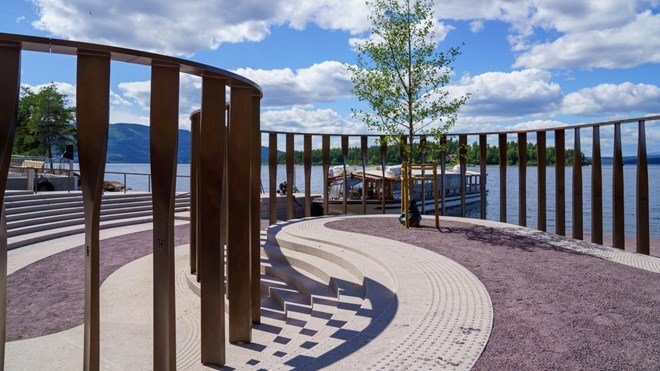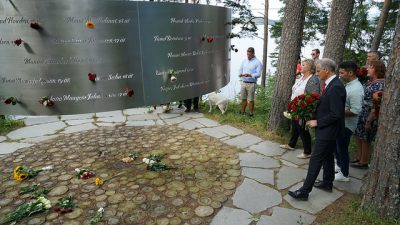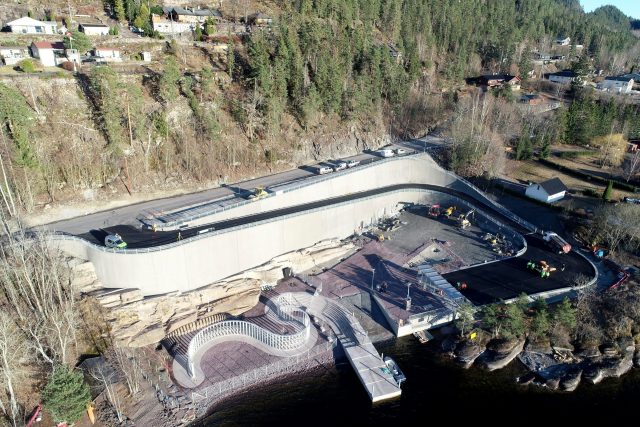Eleven years after 77 people were killed by a young Norwegian right-wing extremist, a national memorial site to remember and honour the victims has formally opened near the scene of the worst violence. It’s been a painful process, but Prime Minister Jonas Gahr Støre was clearly relieved that a monument is now in place.

“We as a nation need a memorial site,” Støre said during the weekend ceremony at Utøyakaia, the pier just across the Tyrifjord from the island where 69 young members of Støre’s Labour Party were gunned down on July 22, 2011.
Støre described the new, long-delayed memorial as “a place that can always remind us of everything we lost, a place where our children and grandchildren can learn about what happened, and about the consequences of right-ring extremism and hate.”
The gunman, who blamed Labour for what he viewed as liberal immigration policy, is now serving a lengthy prison sentence in a jail located on the other side of the same fjord. He first bombed Norway’s government headquarters complex in Oslo, where Labour also held government power at the time, killing eight and injuring several more. Then he drove to Utøya’s ferry pier dressed as a police officer, managed to convince the ferry operator to take him to the island and then set off the most deadly massacre in Norway since World War II. The names of all his victims are written on the pillars, and appear on a temporary memorial at the government complex in the capital. A permanent memorial is also due to be erected there, when reconstruction of the complex is finally completed.

Støre, who was Norway’s foreign minister at the time of the attacks, said he was sorry it had taken so long to get an Utøya memorial in place. Initial designs for one on the island were ultimately rejected, and then there was lots of controversy over where a different memorial should be placed on the mainland. Neighbours fought long and hard in court against the site ultimately chosen, claiming it would increase congestion in the area and force them to be reminded of the massacre every single day. Their property values are also believed to have been cut in half since the attacks, with the state so far refusing to offer any compensation. “This is the thanks we get for saving 28 lives that day,” one bitter local resident told newspaper Dagsavisen Fremtiden.
Several involved in the local rescue operation have received royal medals for their courage on that fateful day, and Crown Prince Haakon attended Saturday’s opening of the memorial site. Prime Minister Støre also hailed their efforts in his remarks at the opening, claiming the memorial itself does so, too. “To those with boats on the Tyrifjord and all neighbours: You didn’t know what threatened (those in the water) but you went out to help youngsters who’d cast themselves in the water. I know that it has been difficult to live with those memories, to feel that that day never releases its grip.” He said he hoped the memorial would now be a place “for us all … with dignity and respect, because we must never forget.”

It will likely take more time for local wounds to heal, though, and the memorial already has cost more than NOK 500 million in planning, delays, construction and legal fees. Neighbours also complain about how the small gravel road leading down to the pier has been transformed into a new paved road fortified by a 10-meter-high concrete wall that towers over the memorial itself. State officials claim vines have been planted to eventually cover the imposing grey wall.
Government officials turned out in full for the opening during the weekend, including several government ministers (one of whom, Tonje Brenna, survived the massacre), the president of the Norwegian Parliament and the current leader of Labour’s youth organization AUF, Astrid Hoem. All of them expressed hopes that the public will visit the memorial to recall the tragedy, “to cry and then fight for our fellowship, tolerance and diversity.”
Also among those attending the opening was Norway’s labour prime minister in 2011, Jens Stoltenberg, now secretary general of NATO and having to devote most of his attention to Russia’s invasion of Ukraine and the war that unleashed in Europe. He told news bureau NTB that he’s relieved a memorial is finally in place.
“This was among the worst terrorist attacks that have occurred in Europe, and it was an attack on our democracy,” Stoltenberg said. “This memorial is about those who were killed, but also the political message that we must never forget, never stay silent. We must do everything we can so that it won’t happen again.”
newsinenglish.no/Nina Berglund

